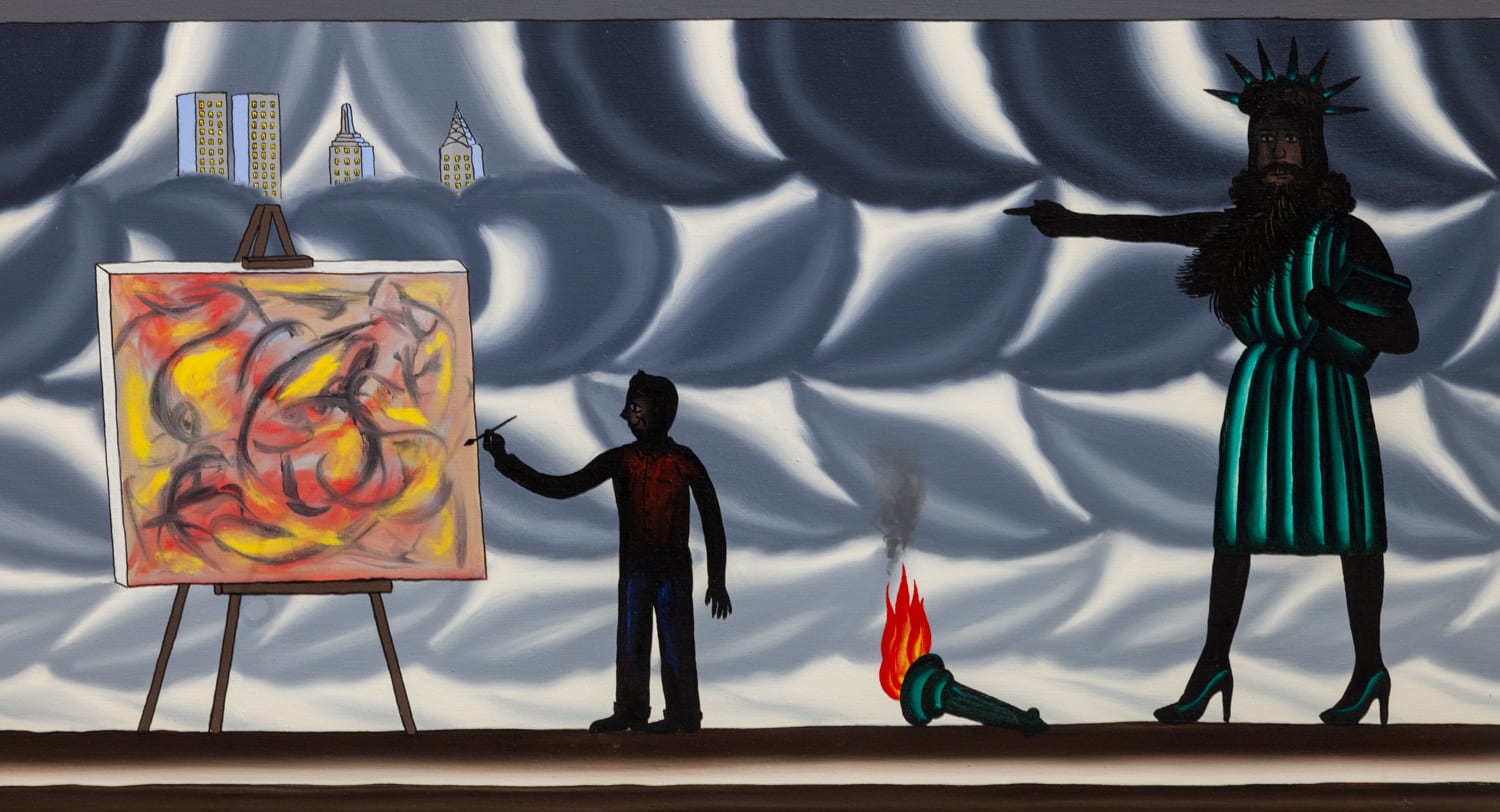-
Artworks
Roger Brown
La Cage Aux Folles (Only The Names Are Changed to Protect the Innocent), 1986Oil on canvas72 x 48 x 2 in
182.9 x 121.9 x 5.1 cm4865Further images
Throughout his career, Brown regularly satirized the state of the contemporary art world, which he equally loved and criticized. One of Brown's most specific fixations was a feeling that structured,...Throughout his career, Brown regularly satirized the state of the contemporary art world, which he equally loved and criticized. One of Brown's most specific fixations was a feeling that structured, purposeful, content-rich painting had largely been abandoned for pure abstraction, as is reflected in this piece which lightly mocks Jackson Pollack. While Brown wasn't entirely opposed to this kind of pure formal abstraction, he felt that it dominated the conversation around the arts to such a degree as to be disruptive and silencing. Here, Brown renders Chicago art critic Alan Artner in drag as "Ellen Artless," a kind of aesthetic revenge against Artner's perceived homophobia and rejection of camp, as Brown notes in the second panel. While the piece could plausibly be read as a specific attack on Artner, the larger conversation Brown was having in his "art world satire" paintings was chiefly a feeling that too much of the art world revolved around New York, and a regressive obsession with reliving past glories of midcentury blue-chip art stars.
Transcription of the painting's own text as follows-
Panel 1: Ellen Artless, super critic and part-time private eye, has discovered that the Art School of Chicago is full of Imagist aggressors who are forcing young wimps who have no wills of their own into becoming second generation Imagists. She feels it is her duty to expose this criminal situation and indict those responsible. In order to achieve those ends, she is studying law at the Washington Post with Professors Woodward and Bernstein.
Panel 2: Ellen Artless, super critic and homophobe, has a full face of hair. This has given her a fear of high camp and a fear of turning into Alice B. Toklas. She believes the Imagist conspiracy is being foisted on an unwilling public by crack art dealer Mary Mean and an evil cabal of high camp homos and certain individuals of a religious minority who live on East Lake Shore Drive, Glencoe, and Hyde Park.
Panel 3: Ellen Artless, super critic, part-time private eye and hysteric, sees her duty as pointing the true way for all artists. The direction she seeks is the return to looking toward New York for inspiration like she feels artists did in the good old days. One of the truly mindless wimps who became her protege declared that Jackson P. didn't know what he was doing. Therefore no artist should ever know what he or she is doing when making a work of art.Provenance
Artist Studio, Chicago
Phyllis Kind Gallery, Chicago
Roger Brown Study Collection, Chicago
Kavi Gupta, ChicagoExhibitions
2020, Roger Brown, HYPERFRAME, Kavi Gupta, ChicagoLiterature
Transcription:
Panel 1: Ellen Artless, super critic and part-time private eye, has discovered that the Art School of Chicago is full of Imagist aggressors who are forcing young wimps who have no wills of their own into becoming second generation Imagists. She feels it is her duty to expose this criminal situation and indict those responsible. In order to achieve those ends, she is studying law at the Washington Post with Professors Woodward and Bernstein.
Panel 2: Ellen Artless, super critic and homophobe, has a full face of hair. This has given her a fear of high camp and a fear of turning into Alice B. Toklas. She believes the Imagist conspiracy is being foisted on an unwilling public by crack art dealer Mary Mean and an evil cabal of high camp homos and certain individuals of a religious minority who live on East Lake Shore Drive, Glencoe, and Hyde Park.
Panel 3: Ellen Artless, super critic, part-time private eye and hysteric, sees her duty as pointing the true way for all artists. The direction she seeks is the return to looking toward New York for inspiration like she feels artists did in the good old days. One of the truly mindless wimps who became her protege declared that Jackson P. didn't know what he was doing. Therefore no artist should ever know what he or she is doing when making a work of art.









